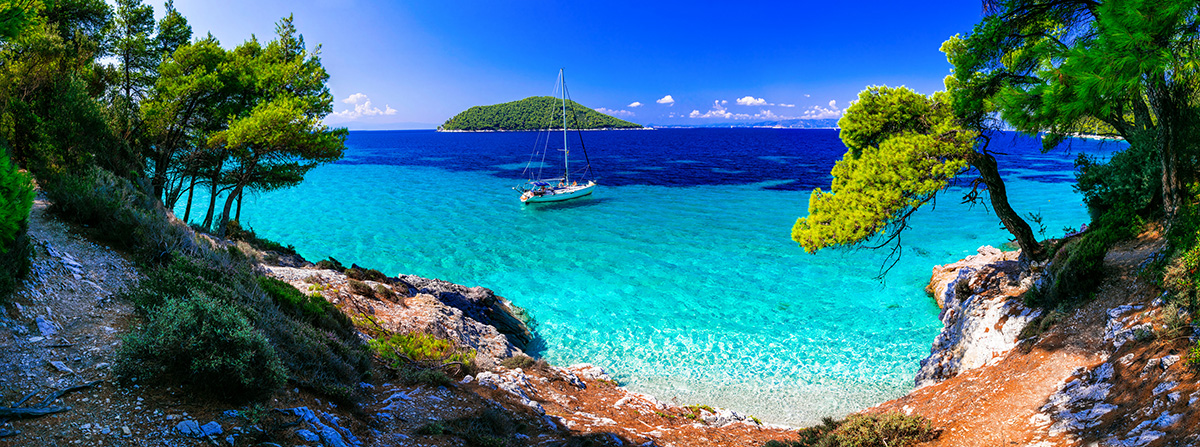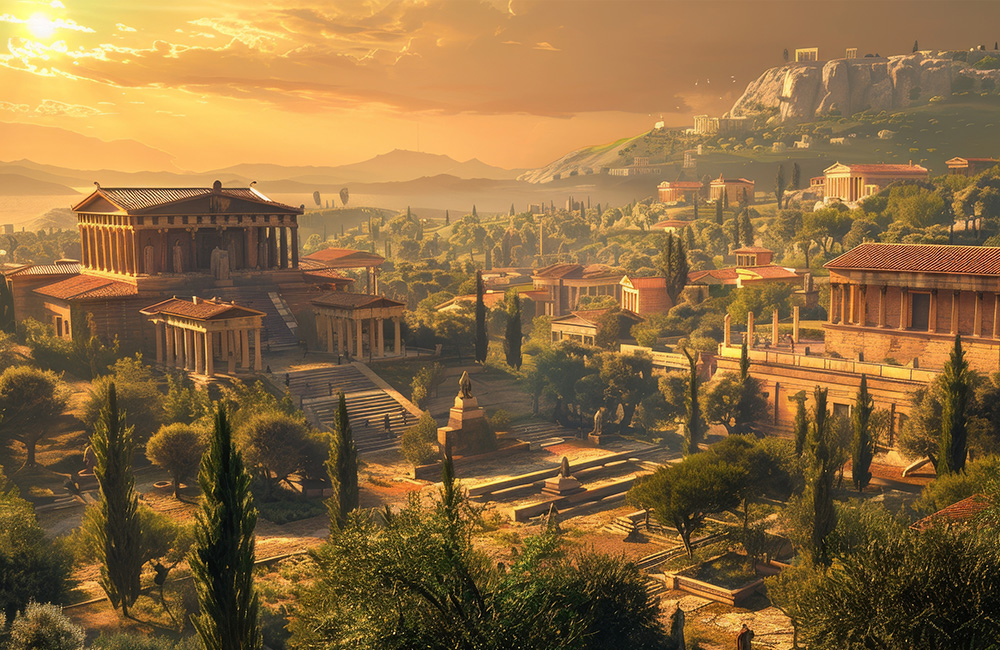
Greece is not just a country, but a true cradle of civilization, where sea and land hold ancient legends. Traveling through its waters on a yacht is like turning the pages of myths, where history, navigation and culture are intertwined into a single exciting adventure. Great Hellas gave the world not only philosophy and democracy, but also the foundations of navigation: the first nautical charts were invented by Eratosthenes, and Hipparchus created astronomical tables that allowed captains to find their way through the stars. It is this knowledge, born in antiquity, that we still use today.
Most popular destinations:
Saronic Islands – first steps in a world of legends
The Saronic Islands are an archipelago of 20 islands, 7 of which are inhabited. It is an ideal itinerary for beginner yachtsmen: calm waters, short crossings and proximity to Athens make the trip comfortable and exciting.
Itinerary (7-10 days)
📍 Athens (Alimos) → Aegina → Agistri → Poros → Idra → Spetses → Peloponnese (Nafplion) → Monemvasia → Athens.
Athens is not only the historical heart of Greece, but also one of the largest yachting hubs in the country. Before departure it is worth visiting the Acropolis, strolling through the picturesque streets of Plaka and checking out the colorful Monastiraki market. Alimos Marina is Greece’s largest charter port, ideal for the start of a sea voyage.
Aegina (20 miles, 3-4 hours) – Famous for the temple of Aphaia , which together with the Parthenon and the temple of Poseidon forms the “sacred triangle”. The island is also called “pistachio heaven” – be sure to try the local pistachio ice cream and liqueur.
Agistri (5 miles, 1 hour) is a green island with crystal clear beaches. Excellent anchorages at Skala and Megalochori bays.
Poros (12 miles, 2-3 hours) – an island with a picturesque harbor, pine forests and cozy taverns. Fresh seafood at the Oasis Tavern overlooking the sea is worth trying here.
Idra (15 miles, 3-4 hours) is an island where cars are forbidden. Narrow streets, 18th-century houses and maritime history create a unique atmosphere. Parking in the marina is best done in the morning, as there are almost no spaces available in the evening.
Spetses (10 miles, 2-3 hours) is an aristocratic island whose fleet played a key role in liberating Greece from the Ottomans in 1821. The best anchorages are in the bays of Balti and Dapia. The traditional almond dessert amygdaloto is worth a treat here.
ThePeloponnese (20 miles, 4-5 hours) is a region of ancient cities and fortresses.
Nafplion is one of the most beautiful cities of the Peloponnese and the first capital of Greece. Here the Venetians erected the fortress of Palamidi. According to legend, the one who climbs all 999 steps will receive Poseidon’s blessing. A convenient parking lot is at the fortress of Burdzi. Nearby are Mycenae, where the golden mask of Agamemnon was found, and the ancient theater of Epidaurus with perfect acoustics.
Monemvasia is a medieval fortress city carved into the rock. Once an important trading port of Byzantium, it has preserved its ancient walls and churches, and a walk through its narrow streets is a real journey through time.
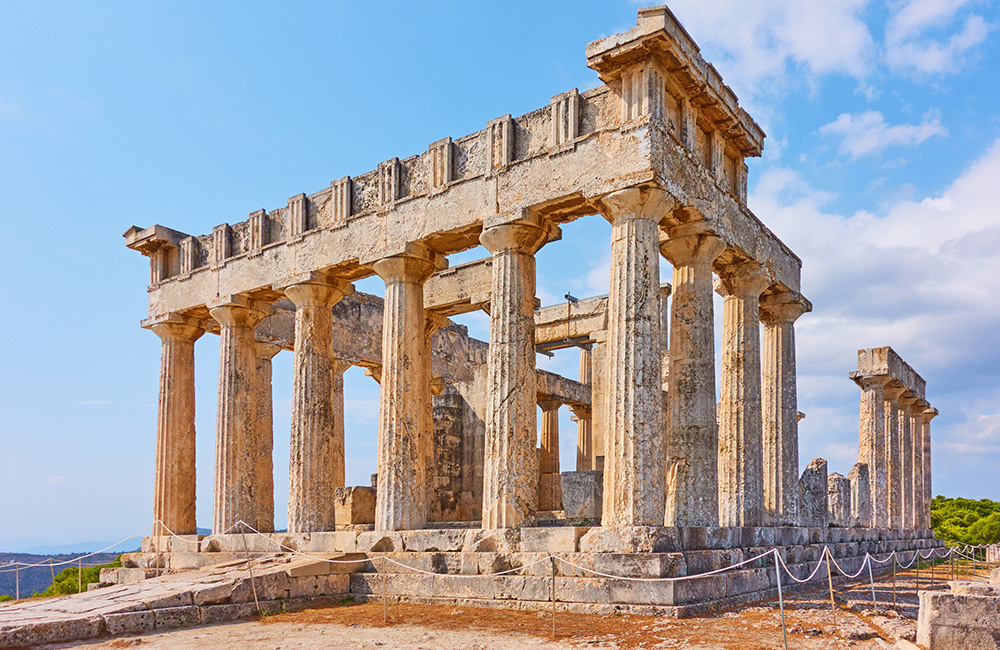
Temple of Aphaia — the guardian of Aegina, where gods and sea whisper.
The Cyclades are a dance of wind and myth
The Cyclades are an archipelago dominated by strong Meltemi winds, long passages and limited anchorages. It is a challenge for yachtsmen and a reward for those ready to encounter the real magic of the Aegean. Of the 220 islands, only 24 are inhabited, forming a maze of white marble, blue sea and ancient myths.
Popular itinerary (7-10 days)
📍 Lavrion → Kythnos → Syros → Paros → Naxos → Ios → Santorini → Lavrion
Lavrion is a great alternative to Alimos Marina, just 37km from Athens airport. In ancient times silver was mined here, which financed the Athenian navy. Today it is a convenient starting point for a trek around the Cyclades.
Kythnos (25 miles, ~4 hours) is the island of Loutra thermal springs, known since Roman times, and secluded coves with azure waters. At local tavernas, try the traditional xinomizitra cheese.
Syros (30 miles, ~5 hours) is the capital of the Cyclades with Venetian style architecture. Ermoupolis is called “little Venice” and the Apollo Theater is a scaled-down replica of Milan’s La Scala. Lukum, fragrant fennel sausages and other traditional delicacies await visitors to the island.
Paros (22 miles, ~4 hours) – Famous for the white marble from which the Venus of Milos is carved. Mooring is possible in Naoussa or Parikia. Among the island’s gastronomic finds are ragu revetta and cheese graviera.
Naxos (12 miles, ~2 hours) is the greenest island of the Cyclades, famous for the unfinished temple of Apollo. Legend has it that Dionysus hid here to escape the wrath of Hera. The island produces the legendary Kitron liqueur and the aged cheeses Arseniko and Kefalotiri.
Ios (23 miles, ~4 hours) is a youthful island with a bustling nightlife and the golden beaches of Mangari and Moulopotas. Honey loukoumades and fresh seafood are worth sampling here.
Santorini (21 miles, ~4 hours) is a volcanic island with whitewashed houses where legend says the spirits of the gods hid and perhaps this is where Atlantis went underwater, leaving its secrets among lava rocks and vineyards. The best parking lots are Tirassia, and sunsets at Ia and Fira are among the most picturesque in the world. Local winemakers suggest trying Assyrtiko, and tomato fritters and white eggplant are perfect for an appetizer.
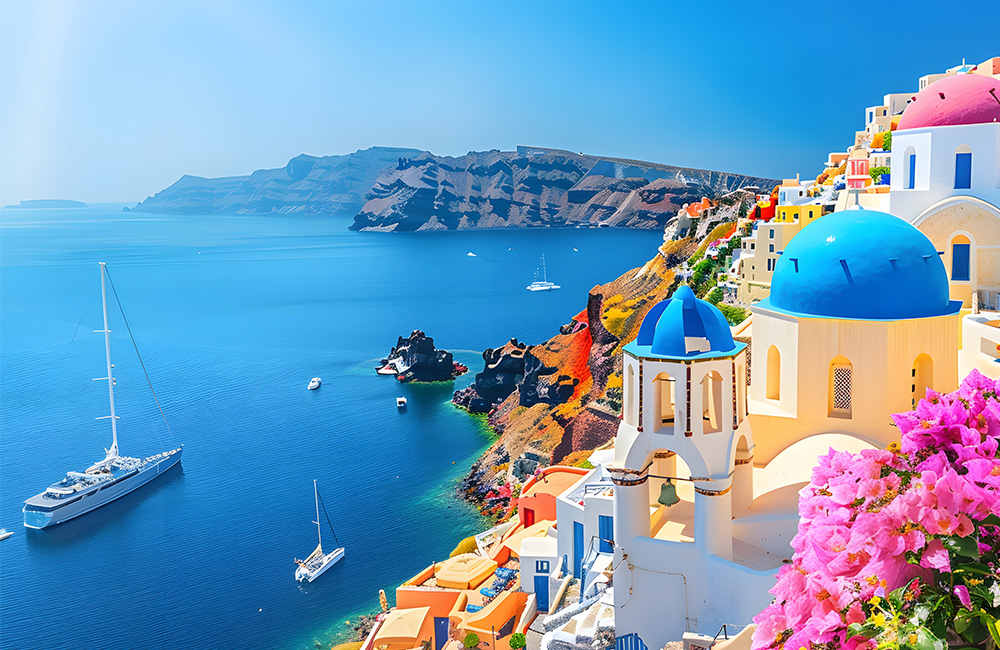
Santorini – where the gods left their footprints
Crete is the cradle of the sea kings
Crete is Greece’s largest island, known for its difficult passages, strong currents and rich history. It was here, in the Bronze Age, that King Minos founded the first maritime power, and his fleet controlled the trade routes from Egypt to the Cyclades. And the narrow hulls of his ships became the basis for future shipbuilding. Crete is a mix of ancient ruins, picturesque bays and unique cuisine.
Itinerary (7-10 days) in the eastern part of Crete
📍 Heraklion → Agios Nikolaos → Chrysi Island → Sitia → Heraklion
Heraklion is the capital of Crete and a convenient starting point. Here is the Palace of Knossos, decorated with frescoes and labyrinths, where, according to myths, the Minotaur dwelt. Not far away are the Samaria Gorge (16 km) – the longest in Europe, and Elafonisi beach with pink sand. Cozy taverns serve Cretan moussaka with a delicate texture, crispy calamari and shrimp soaked in the aroma of ouzo.
Agios Nikolaos (35 miles, ~6 hours) is a cozy town with Lake Voulismeni surrounded by restaurants and cafes. Here you can enjoy a leisurely atmosphere and seaside gastronomy.
Chrysi Island (20 miles, ~4 hours) is an uninhabited paradise with golden beaches, turquoise water and ancient cedar groves. An ideal spot for swimming and snorkeling.
Sitia (15 miles, ~2-3 hours) – A small town with a great marina, non-touristy atmosphere and wine-making traditions. Explore the rich bouquet of local wines Vidiano and Liatica, as well as Cretan cheese Xinomisitra.
Return to Heraklion – the route takes you along the picturesque coastline with possible stops at secluded bays.

Knossos Palace – the heart of the Minotaur myth
Ionian Islands – Odysseus’ green dreams
The Ionian Sea is a turquoise surface, emerald cliffs and islands dotted with olive groves. It has calm waters and a mild climate thanks to the westerly winds, making the region ideal for yachtsmen of all levels.
Itinerary (7-10 days)
📍 Corfu → Paxos → Lefkada → Ithaca → Kefalonia → Zakynthos → Kefalonia → Lefkas → Paxos → Corfu.
Corfu is the largest island of the Ionian Archipelago, once an important staging post for the Romans and Venetians. Its Old Town is a UNESCO site. Marina Gouvia is the island’s main yacht harbor, located just 6 km from the town. It is from here that your journey through the Ionian Islands begins.
Paxos (30 miles, 6 hours) is a tiny island with turquoise lagoons and the famous Blue Caves. Pastitsada and bourdetto at local tavernas are worth sampling here.
Lefkas (35 miles, 7 hours) is an island connected to the mainland by a bridge. Its main attractions are the Lefkada Canal and secluded coves. Don’t miss the fried fish with egloumena sauce and traditional sfugato.
Ithaca (20 miles, 4 hours) is the birthplace of Odysseus, where Homer’s myths come to life among rocky coves. In Phoki Bay, it’s especially nice to enjoy a cremidopita (onion pie) accompanied by a glass of Robola white wine.
Kefalonia (15 miles, 3 hours) is an island with unique natural wonders: the Melissani Cave with its underground lake and Drogarati with its excellent acoustics, which hosts concerts.
Zakynthos (25 miles, 5 hours) – famous for Navagio beach, surrounded by snow-white rocks, where in the 1980s a smugglers’ ship was thrown away – now it is the symbol of the island. It’s also home to the caretta caretta sea turtles.
On the way back to Corfu it is worth spending the night in the cozy port of Fiskardo on Kefalonia, make stops on the islands of Kastos and Kalamos, where you can taste lagoto and fried cheese saganake.
At the end of the journey, stroll through the narrow streets of Corfu’s Old Town and try a sofrito with a glass of kumquat liqueur.
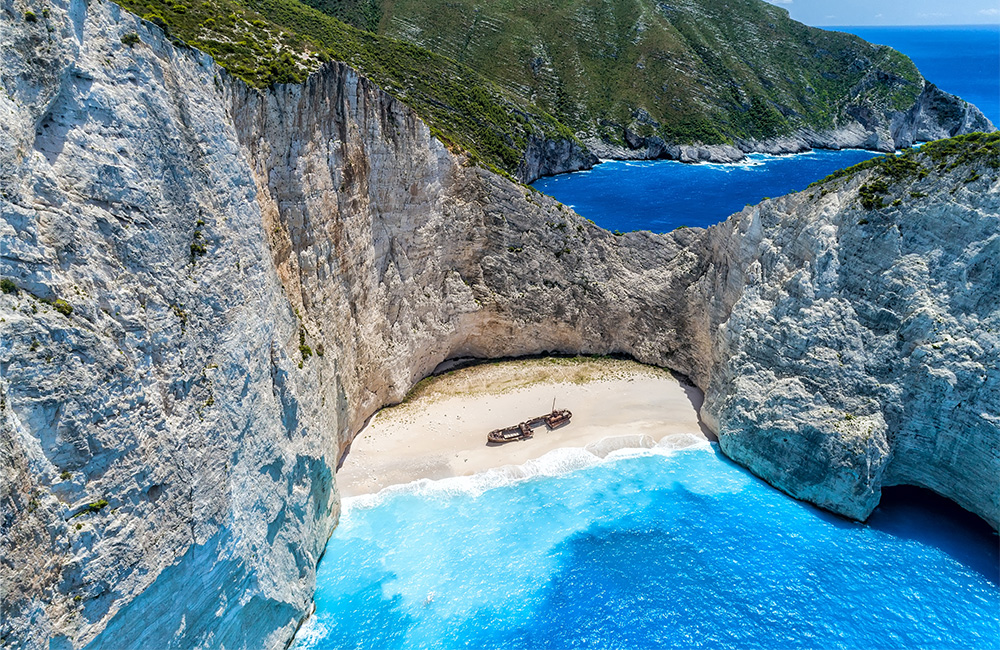
Zakynthos holds the secrets of Navagio beach
The Dodecanese is the crossroads of empires
The islands of the Dodecanese are where Greek and Ottoman cultures meet and ancient history intertwines with modernity. There are 12 large islands and about 150 small islands spread on the border with Turkey.
The itinerary is suitable for yachtsmen with an average level of training, especially taking into account the gusty winds of the Meltemi during the season.
Itinerary (7-10 days):
📍 Rhodes > Symi > Tilos > Nisyros > Kos > Leros > Patmos > Rhodes
Rhodes is the center of maritime knowledge, where the Colossus of Rhodes, one of the Seven Wonders of the World, once stood. The medieval town of the Ioannite Knights survives to this day, and you can start your journey at Mandraki Marina, having your morning coffee with rice pudding risagalo.
Simi (23 miles, 4-5 hours) is a true gem of the Dodecanese. Charming colorful 19th-century neoclassical houses make the island one of the most picturesque places in Greece. Be sure to visit the hilltop Panagia Monastery, and try the famous Simian shrimp in the waterfront taverns of Nimborio.
Tilos (22 miles, 4-5 hours) is a secluded island with wildlife and protected beaches. Village taverns here serve traditional bean soup fasolada.
Nisyros (18 miles, 3-4 hours) is an island with an active volcano. Stop in the village of Nikia to enjoy panoramic views and sample a flavorful kapama stew.
Kos (19 miles, 4 hours) is the birthplace of Hippocrates and a center of ancient medicine. Here are the ruins of Asklepion, the first Greek sanitarium.
Leros (28 miles, 5 hours) is an island with a picturesque capital Plakatos, where you can taste a local delicacy: Lerian fish in tomato sauce.
Patmos (24 miles, 5 hours) is the spiritual center of Greece. It was here, in the Cave of the Apocalypse, that John the Theologian wrote his revelations. Above it rises a majestic 11th-century monastery that resembles a fortress.
This itinerary combines ancient history, natural beauty and the delicious flavors of Greek cuisine.
Sporades – the secret coves of mermaids
The islands of Sporades are a little-known but enchanting corner of Greece. They are scattered in the Aegean Sea, and only 4 of the 24 islands are inhabited. Moderate winds, many sheltered bays and convenient anchorages make this route comfortable and picturesque.
Itinerary (7-10 days):
📍 Volos > Skiathos > Skopelos > Alonisos > Peristera > Kira-Panaia > Skiathos > Volos
Volos is mainland Greece, at the foot of Mount Pilion, 4 hours from Athens. It is the main starting point for a yachting trip in the Sporades.
Skiathos (25 miles, 4-5 hours) is an island with 70 beaches, including the famous Lalaria with its white pebbles, accessible only from the sea. The island’s forests are home to rare birds.
Skopelos (20 miles, 4 hours) is a verdant paradise where you’ll be greeted by a cozy harbor with white houses. Don’t miss the opportunity to try traditional tiropita cheese pies. The island’s underwater grottos are said to still hold the treasures of mermaids.
Alonissos (15 miles, 3-4 hours) is a national marine park, a protected area for monk seals. It has wild beaches, caves and some of the best diving in Greece.
Peristera (10 miles, 2 hours) is a secluded island ideal for overnight anchorage.
Kira-Panaia (12 miles, 3 hours) is a small island with a picturesque monastery bay where you can enjoy peace and tranquility.
Returning to civilization, enjoy a rest in the tavernas of Skiathos and a leisurely stroll through the cozy streets of Volos.
This itinerary will give you secluded coves, the natural beauty of Sporades and a comfortable yachting vacation.
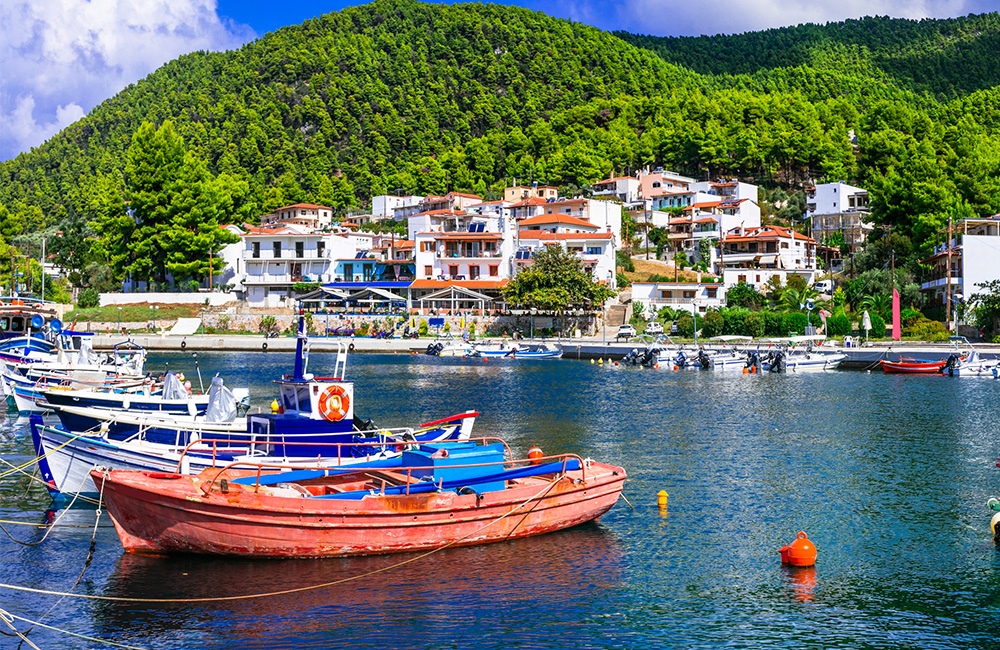
Skopelos is a green paradise
North Aegean Sea – islands of poets and volcanoes
This 10-14 day itinerary opens up a lesser known but authentic part of Greece. Non-touristy, tranquil islands, moderate winds and long passages for experienced sailors await you here.
📍 Kavala > Thassos > Lemnos > Lesvos > Chios > Samos > Kavala
Kavala is a port city in northeastern Greece, the main yachting and ferry hub of the North Aegean Sea. It is home to the most popular marina for the start of voyages.
Thassos (18 miles, 3-4 hours) – A verdant island with cozy coves and a convenient marina in Limenas. A great place for a first crossing and getting to know the local atmosphere.
Lemnos (50 miles, 8-10 hours) – An island with volcanic landscapes, red beaches and the fortress of Myrina, where, according to myth, Hephaestus fell from Olympus. After a long crossing, rest up and try fakeses (lentil soup) with flavorful local bread.
Lesbos (40 miles, 6-8 hours) – The Island of the poetess Sappho. It is home to a unique petrified forest that is 20 million years old. In the port of Mytilini, enjoy ouzo with traditional meze.
Chios (45 miles, 7-9 hours) – The island of mastic, which since antiquity has been extracted from the resin of coniferous trees. This ingredient is added to liqueurs, desserts and ice cream.
Samos (35 miles, 5-7 hours) – Home of Pythagoras and the goddess Hera. Here are the temple of Hera (Heraion) and the Eupalina Tunnel, an engineering feat of the 6th century B.C. Samos is famous for its Muscat wine, served with traditional appetizers: dolmathes and saganake.
Return to Kavala – A final crossing completes the journey across the North Aegean Sea.
Traveling through Greece by yacht turns the map into a living book where ancient legends, myths and historical discoveries merge into one exciting adventure that inspires new discoveries and reveals the soul of this fascinating country.
You are the continuation of this great tradition, where every nautical mile opens not just new horizons, but also the past and future of navigation.
